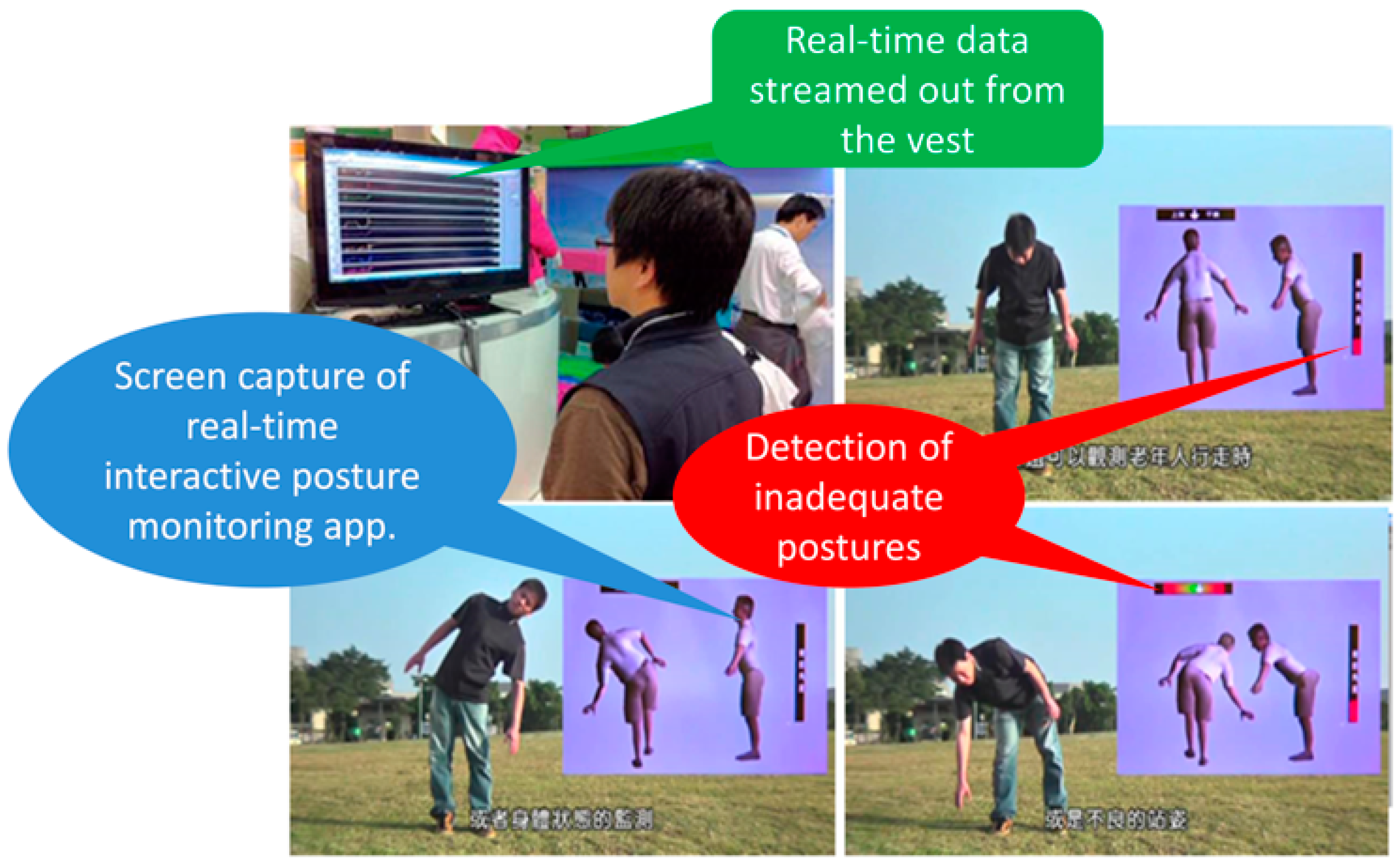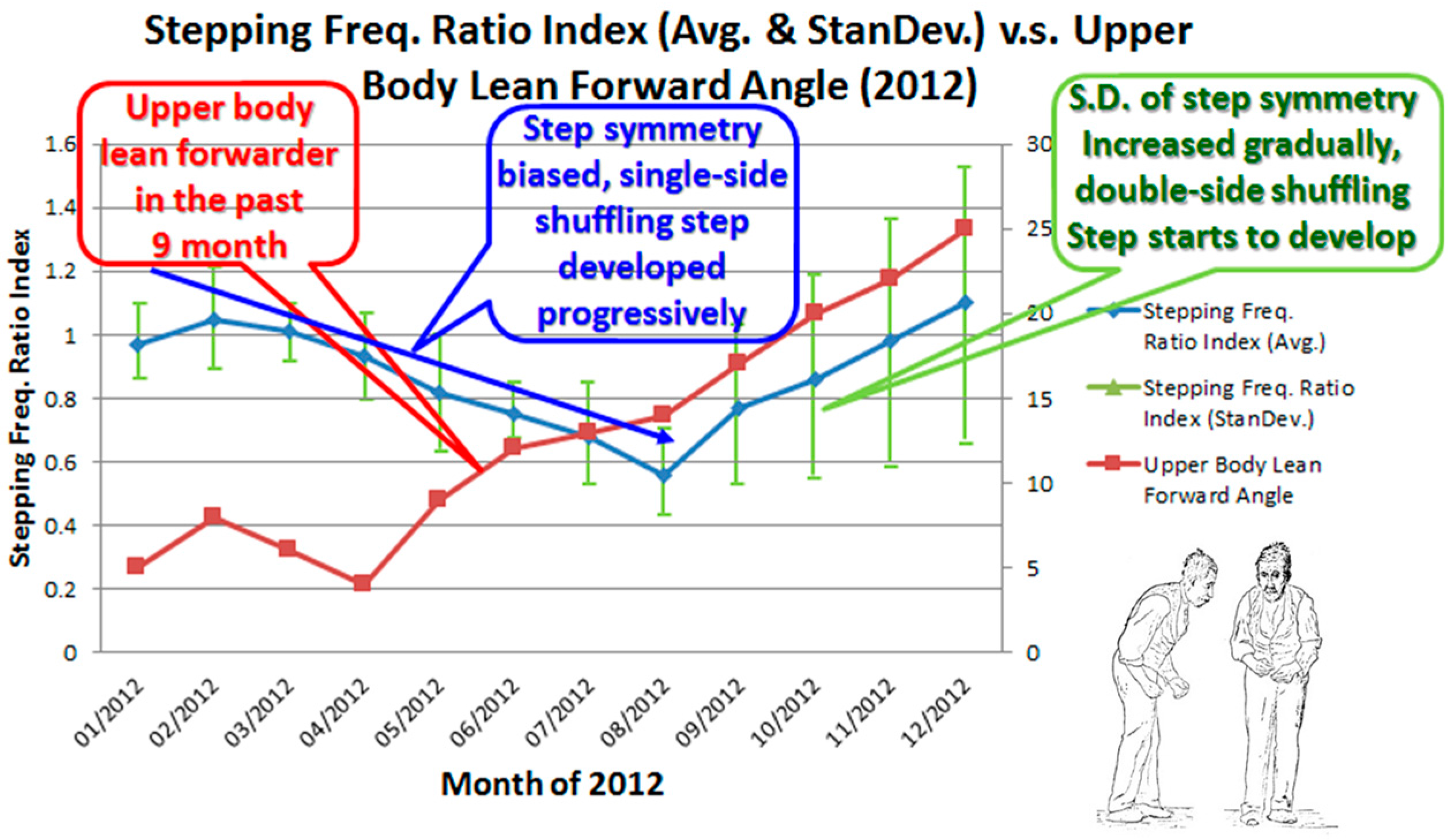Development of a Wearable Instrumented Vest for Posture Monitoring and System Usability Verification Based on the Technology Acceptance Model
Abstract
:1. Introduction
2. Materials and Methods
2.1. Design and Development of the Wearable Instrumented Vest
2.2. TAM-Based Usability Verification
- H1: Technology anxiety is negatively correlated with the perceived usefulness of using a posture-monitoring vest.
- H2: Technology anxiety is negatively correlated with the perceived ease of use of a posture-monitoring vest.
- H3: Perceived ease of use is positively correlated with the perceived usefulness of a posture-monitoring vest.
- H4: Perceived ease of use is positively correlated with attitudes toward using a posture-monitoring vest.
- H5: Perceived usefulness is positively correlated with attitudes toward using a posture-monitoring vest.
- H6: Attitude is positively correlated with the behavioral intention to use a posture-monitoring vest.
3. Results
3.1. Developed Wearable Instrumented Vest
3.2. Usability with Technological Acceptance Analysis among Elderly People
4. Discussion
4.1. Applications for the Wearable Instrumented Vest
4.2. TAM-Based Usability Analysis for Wearable Instrumented Vest
5. Conclusions
Supplementary Materials
Acknowledgments
Author Contributions
Conflicts of Interest
References
- Lin, W.-Y.; Chou, W.-Z.; Wu, W.-S.; Lee, M.-Y. An Accelerometer-based Festinating Gait Detection Algorithm and Its Application to Parkinson’s Disease Development. In Proceedings of the 2016 IEEE International Conference on Systems, Man, and Cybernetics, Budapest, Hungary, 9–12 October 2016.
- Jellish, J.; Abbas, J.J.; Ingalls, T.M.; Mahant, P.; Samanta, J.; Ospina, M.C.; Krishnamurthi, N. A System for Real-Time Feedback to Improve Gait and Posture in Parkinson’s Disease. IEEE J. Biomed. Health Inform. 2015, 19, 1809–1819. [Google Scholar] [CrossRef] [PubMed]
- Lee, M.-Y.; Lin, W.-Y.; Lin, C.-F. Development of a Biofeedback Inertial-based Motion Sensing Modality. J. Chin. Soc. Mech. Eng. 2014, 35, 101–108. [Google Scholar]
- Diaz, A.; Prado, M.; Roa, L.M.; Reina-Tosina, J.; Sanchez, G. Preliminary evaluation of a full-time falling monitoring for the elderly. In Proceedings of the 26th Annual International Conference of the IEEE Engineering in Medicine and Biology Society, San Francisco, CA, USA, 1–5 September 2004; pp. 2180–2183.
- Bourke, A.K.; O’Brien, J.V.; Lyons, G.M. Evaluation of a threshold-based tri-axial accelerometer fall detection algorithm. Gait Posture 2007, 26, 194–199. [Google Scholar] [CrossRef] [PubMed]
- Williams, G.; Doughty, K.; Cameron, K.; Bradley, D.A. A smart fall and activity monitor for telecare applications. In Proceedings of the 20th Annual International Conference of the IEEE Engineering in Medicine and Biology Society, Hong Kong, China, 29 October–1 November 1998; pp. 1151–1154.
- Abeyruwan, S.W.; Sarkar, D.; Sikder, F.; Visser, U. Semi-Automatic Extraction of Training Examples from Sensor Readings for Fall Detection and Posture Monitoring. IEEE Sens. J. 2016, 16, 5406–5415. [Google Scholar] [CrossRef]
- Narayanan, M.R.; Redmond, S.J.; Scalzi, M.E.; Lord, S.R.; Celler, B.G.; Lovell, N.H. Longitudinal falls-risk estimation using triaxial accelerometry. IEEE Trans. Biomed. Eng. 2010, 57, 534–541. [Google Scholar] [CrossRef] [PubMed]
- Chou, W.-C.; Lin, W.-Y.; Lee, M.-Y.; Lei, K.F. Design and assessment of a real-time accelerometer-based lying-to-sit sensing system for bed fall prevention. In Proceedings of the 2013 IEEE International Conference on Systems, Man, and Cybernetics, Manchester, UK, 13–16 October 2013.
- Xsens—The Leading Innovator in 3D Motion Tracking Technology. Available online: https://www.xsens.com (accessed on 15 December 2016).
- APDM—Wearable Technologies. Available online: http://www.apdm.com (accessed on 15 December 2016).
- Teichmann, D.; Kuhn, A.; Leonhardt, S.; Walter, M. The MAIN Shirt: A Textile-Integrated Magnetic Induction Sensor Array. Sensors 2014, 14, 1039–1056. [Google Scholar] [CrossRef] [PubMed]
- Halin, N.; Junnila, M.; Loula, P.; Aarnio, P. The LifeShirt system for wireless patient monitoring in the operating room. J. Telemed. Telecare 2005, 11, 41–43. [Google Scholar] [CrossRef] [PubMed]
- Poon, C.C.Y.; Liu, Q.; Gao, H.; Lin, W.-H.; Zhang, Y.-T. Wearable intelligent systems for e-health. J. Comput. Sci. Eng. 2011, 5, 246–256. [Google Scholar] [CrossRef]
- Lin, W.-Y.; Lee, M.-Y.; Chou, W.-C. The design and development of a wearable posture monitoring vest. In Proceedings of the IEEE International Conference on Consumer Electronics, Las Vegas, NV, USA, 10–13 January 2014; pp. 333–334.
- Liao, W.-T.; Chou, W.-C.; Lin, W.-Y.; Lei, K.F.; Tsai, W.-W.; Lee, M.-Y. CORDIC-based inclination sensing algorithm using three-axis accelerometer-based inertial sensors. In Proceedings of the 2011 4th International Conference on Biomedical Engineering and Informatics (BMEI 2011), Shanghai, China, 15–17 October 2011; pp. 705–709.
- Volder, J.E. The CORDIC trigonometric computing technique. IRE Trans. Electron. Comput. 1959, 8, 330–334. [Google Scholar] [CrossRef]
- Liao, W.-T.; Lin, W.-Y.; Chou, W.-C.; Lei, K.F.; Lee, M.-Y. Precision enhancement and performance evaluation of a CORDIC-based tilting angle identification algorithm for three-axis accelerometers. In Proceedings of the 2013 International Symposium on Biometrics and Security Technologies (ISBAST’13), Chengdu, China, 2–5 July 2013.
- Yao, X.; Lin, W.-Y.; Chou, W.-C.; Lei, K.F.; Lee, M.-Y.; Sun, G. The Design of an In-Line Accelerometer-Based Inclination Sensing System. In Proceedings of the 2012 IEEE International Symposium on Circuits and Systems (ISCAS 2012), Seoul, Korea, 20–23 May 2012; pp. 333–336.
- Hsiao, C.-H.; Tang, K.-Y. Examining a Model of Mobile Healthcare Technology Acceptance by the Elderly in Taiwan. J. Glob. Inf. Technol. Manag. 2015, 18, 292–311. [Google Scholar] [CrossRef]
- Kuo, K.-M.; Liu, C.-F.; Ma, C.-C. An investigation of the effect of nurses’ technology readiness on the acceptance of mobile electronic medical record systems. BMC Med. Inform. Decis. Mak. 2013, 13, 88. [Google Scholar] [CrossRef] [PubMed]
- Wu, L.; Li, J.-Y.; Fu, C.-Y. The adoption of mobile healthcare by hospital’s professionals: An integrative perspective. Decis. Support Syst. 2011, 51, 587–596. [Google Scholar] [CrossRef]
- Folstein, M.F.; Folstein, S.E.; McHugh, P.R. “Mini-mental state”: A practical method for grading the cognitive state of patients for the clinician. J. Psychiatr. Res. 1975, 12, 189–198. [Google Scholar] [CrossRef]
- Thatcher, J.B.; Perrewe, P.L. An empirical examination of individual traits as antecedents to computer anxiety and computer self-efficacy. MIS Q. 2002, 26, 381–396. [Google Scholar] [CrossRef]
- Davis, F.D. Perceived usefulness, perceived ease of use, and user acceptance of information technology. MIS Q. 1989, 13, 319–340. [Google Scholar] [CrossRef]
- Fishbein, M.; Ajzen, I. Belief, attitude, intention, and behavior: An introduction to theory and research. Philos. Rhetor. 1977, 10, 130–132. [Google Scholar]
- Ajzen, I. The theory of planned behavior. Organ. Behav. Hum. Decis. Process. 1991, 50, 179–211. [Google Scholar] [CrossRef]
- Loehlin, J.C. Latent Variable Models: An Introduction to Factor, Path, and Structural Analysis; Lawrence Erlbaum Associates Publishers: Mahwah, NJ, USA, 1998. [Google Scholar]
- Chang, S.J.; Im, E.-O. A path analysis of Internet health information seeking behaviors among older adults. Geriatr. Nurs. 2014, 35, 137–141. [Google Scholar] [CrossRef] [PubMed]
- Guo, X.; Sun, Y.; Wang, N.; Peng, Z.; Yan, Z. The dark side of elderly acceptance of preventive mobile health services in China. Electron. Markets 2013, 23, 49–61. [Google Scholar] [CrossRef]
- Lin, W.-Y.; Chou, W.-C.; Chang, P.-C.; Chou, C.-C.; Wen, M.-S.; Ho, M.-Y.; Lee, W.-C.; Hsieh, M.-J.; Lin, C.; Tsai, T.-H.; et al. Identification of Location Specific Feature Points in a Cardiac Cycle Using a Novel Seismocardiogram Spectrum System. IEEE J. Biomed. Health Inform. 2016. [Google Scholar] [CrossRef]





| Testing Items | Results |
|---|---|
| Conductive Textile | |
| maximum wire length | 90 cm |
| conductivity | 0.2 Ω/10 cm |
| isolation | Open (>100 MΩ) |
| Vest | |
| washability (remove all sensing modules and the gateway) | Pass |
| Sensors | |
| location robustness | Pass |
| average of in steady state | 1 g ± 3% |
| standard deviation of | <±3% |
| drift test (signal variation after 12 h) | <±0.05% |
| Exogenous Variable | Endogenous Variable | Standardized Regression Coefficient | t-Value | p-Value | Support | |
|---|---|---|---|---|---|---|
| Technology Anxiety | → | Perceived Usefulness | −0.05 | −0.34 | >0.05 | No |
| Technology Anxiety | → | Perceived Ease of Use | −0.63 | −5.65 | <0.001 | Yes |
| Perceived Ease of Use | → | Perceived Usefulness | 0.66 | 4.99 | <0.001 | Yes |
| Perceived Ease of Use | → | Attitude | 0.37 | 3.25 | <0.01 | Yes |
| Perceived Usefulness | → | Attitude | 0.52 | 4.59 | <0.001 | Yes |
| Attitude | → | Behavioral Intention | 0.81 | 9.76 | <0.001 | Yes |
© 2016 by the authors; licensee MDPI, Basel, Switzerland. This article is an open access article distributed under the terms and conditions of the Creative Commons Attribution (CC-BY) license (http://creativecommons.org/licenses/by/4.0/).
Share and Cite
Lin, W.-Y.; Chou, W.-C.; Tsai, T.-H.; Lin, C.-C.; Lee, M.-Y. Development of a Wearable Instrumented Vest for Posture Monitoring and System Usability Verification Based on the Technology Acceptance Model. Sensors 2016, 16, 2172. https://doi.org/10.3390/s16122172
Lin W-Y, Chou W-C, Tsai T-H, Lin C-C, Lee M-Y. Development of a Wearable Instrumented Vest for Posture Monitoring and System Usability Verification Based on the Technology Acceptance Model. Sensors. 2016; 16(12):2172. https://doi.org/10.3390/s16122172
Chicago/Turabian StyleLin, Wen-Yen, Wen-Cheng Chou, Tsai-Hsuan Tsai, Chung-Chih Lin, and Ming-Yih Lee. 2016. "Development of a Wearable Instrumented Vest for Posture Monitoring and System Usability Verification Based on the Technology Acceptance Model" Sensors 16, no. 12: 2172. https://doi.org/10.3390/s16122172
APA StyleLin, W.-Y., Chou, W.-C., Tsai, T.-H., Lin, C.-C., & Lee, M.-Y. (2016). Development of a Wearable Instrumented Vest for Posture Monitoring and System Usability Verification Based on the Technology Acceptance Model. Sensors, 16(12), 2172. https://doi.org/10.3390/s16122172








